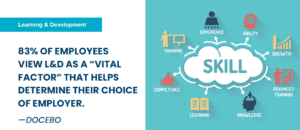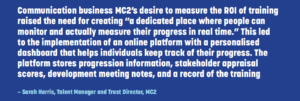Measuring the value of training programmes can be tricky, but these best practices can help guide strategy.
By Simon Kent
Learning and development (L&D) can present HR with a dichotomy. Whilst many see training employees as a worthwhile investment, others feel this investment could only be short term. Unless training programmes are backed with career progression, there is always the possibility that attrition will occur. All of which begs the question: Where does ROI fit into the equation? The short answer is: It’s complicated.
A recent global survey by software company Docebo found that 83% of employees view L&D as a “vital factor” which will determine their choice of employer. Andrew Watson, chief technology officer at HR, payroll, and finance provider MHR, says that L&D initiatives should be deployed to “nurture adaptability in the workplace.” He makes the point that L&D can deliver greater employee flexibility and resilience, which is particularly useful in this day and age when facing challenges like implementing new technologies. “Developing employees in areas outside of their current role broadens individual skill sets enabling businesses to pivot more effectively to meet new demands, utilising existing talent, and saving time and money otherwise spent on recruitment,” he explains.
Martin Coles, customer success coach at GoodHabitz, also believes that training is an essential part of the retention equation, alongside employee experience and career development. “Employers need to create relevant learning opportunities and career pathways so their next role enables them to earn more money, have more responsibility, and continue to grow,” he says.
A more strategic approach is required for L&D provision and Coles recommends leveraging a training needs analysis or a skills matrix. This way, he says, an organisation will understand what skills are needed and will also highlight what to measure, making it easier to understand the value of the investment.
Rashmika Maharaj, head of HR at global remote-first SEO business Pearl Lemon Group, agrees that development can be costly and says that effective utilisation needs to be driven by HR and managers alike. “Communication is essential, and HR and managers should make employees aware of the benefits that can be gained from training and development initiatives,” explains Maharaj.
Maharaj is a firm believer that employees will value L&D as part of their business culture, helping them to feel valued and supported. But it’s wise for HR to conduct an evaluation first before making a large investment in L&D. “Employers need to have a plan of action or one-on-one coaching to identify where their employees’ goals and feelings are,” Maharaj says. “This will provide a clear indicator as to whether employees want to leave the business or stay and are happy. With this kind of information, a business can determine whether to actually launch training initiatives because we wouldn’t want to be training the wrong people with an intent of leaving.”
Laura Everall, HR consultant at employment law business Guardian Support, has another approach to ensure newly trained talent doesn’t leave the business: Draw up an agreement which protects the business from such losses. “Where companies have financially invested in the upskilling or training of staff, it is recommended that a training agreement is signed stipulating the recouping of costs should the employee leave within 12 months of completing the training,” she advises.
Whilst this process helps the business the protect the L&D investment, Everall says measuring ROI continues to be a challenge. “Although it is recommended that any training and development is measured to see that the training has been successful, often companies will measure the success of training in the performance of their role,” she says. “Also, where generic and informative training is requested and provided, assessment is not always required.”
At communication business MC2, Talent Manager and Trust Director Sarah Harris ensures their L&D agenda reflects the business’ strategy before deployment. “Our talent initiatives always stick to our core training pillars that aim to develop, inspire, and reward our employee partners,” she says. “If our programme doesn’t align to those pillars, then we know it’s not a worthwhile initiative.”
Harris says their consideration of ROI from training raised the need for creating “a dedicated place where people can monitor and actually measure their progress in real time.”
This led to the implementation of an online platform with a personalised dashboard, which helps individuals keep track of their progress. The platform stores progression information, stakeholder appraisal scores, development meeting notes, and a record of the training modules attended.
“Our development programme is a retention tool but is also a core part of our business,” says Harris, going on to note how through this, talent is supported to climb the organisational ladder. “Sixty per cent of our executive board joined as graduates and have developed to become directors,” she says. “Fifty per cent of our elected employee-ownership council are also graduates.”
Measuring ROI around L&D initiatives can be as unique as the business and the L&D provision itself. Companies offer these resources to their employees with different intentions–sometimes career or role specific, sometimes simply as part of their culture and retention strategy. Whatever the reason, measurement needs to match the reason for provision because without that link, any programme may appear to be a little more than a tick-box exercise.
















